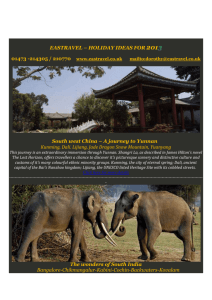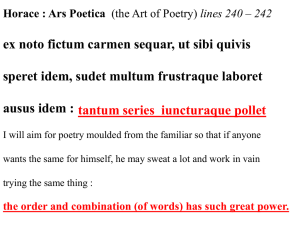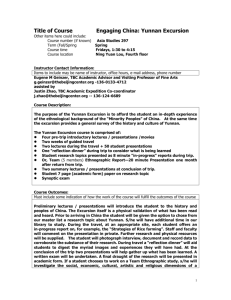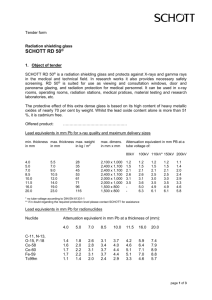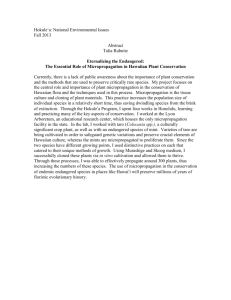New species from China
advertisement
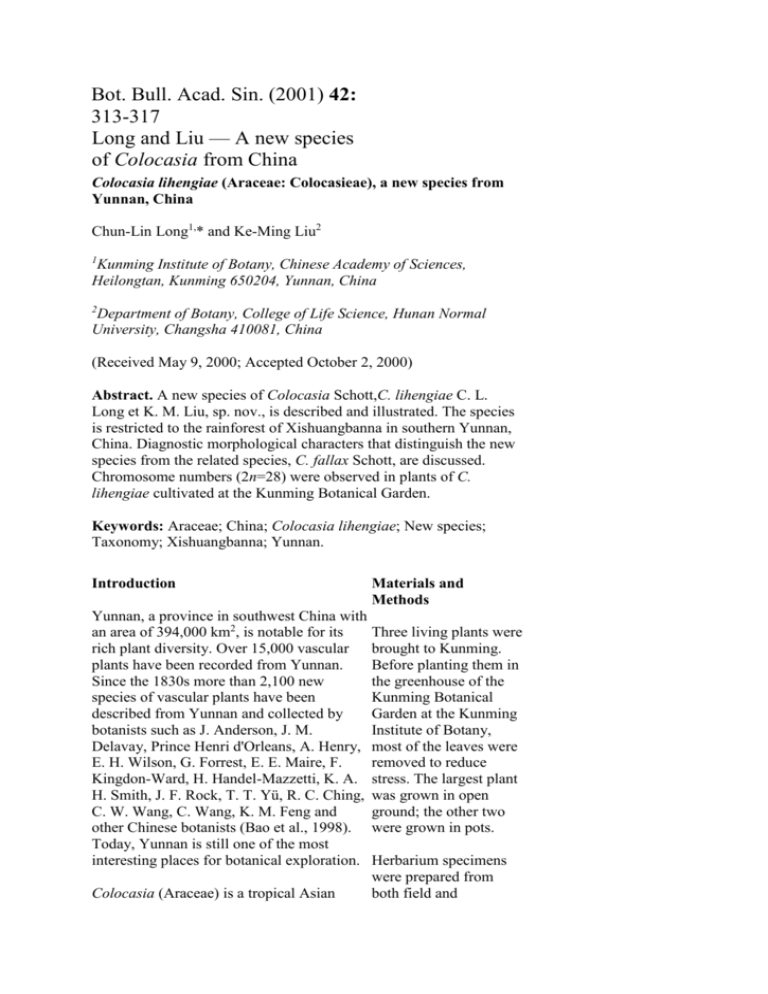
Bot. Bull. Acad. Sin. (2001) 42: 313-317 Long and Liu — A new species of Colocasia from China Colocasia lihengiae (Araceae: Colocasieae), a new species from Yunnan, China Chun-Lin Long1,* and Ke-Ming Liu2 1 Kunming Institute of Botany, Chinese Academy of Sciences, Heilongtan, Kunming 650204, Yunnan, China 2 Department of Botany, College of Life Science, Hunan Normal University, Changsha 410081, China (Received May 9, 2000; Accepted October 2, 2000) Abstract. A new species of Colocasia Schott,C. lihengiae C. L. Long et K. M. Liu, sp. nov., is described and illustrated. The species is restricted to the rainforest of Xishuangbanna in southern Yunnan, China. Diagnostic morphological characters that distinguish the new species from the related species, C. fallax Schott, are discussed. Chromosome numbers (2n=28) were observed in plants of C. lihengiae cultivated at the Kunming Botanical Garden. Keywords: Araceae; China; Colocasia lihengiae; New species; Taxonomy; Xishuangbanna; Yunnan. Introduction Materials and Methods Yunnan, a province in southwest China with an area of 394,000 km2, is notable for its Three living plants were rich plant diversity. Over 15,000 vascular brought to Kunming. plants have been recorded from Yunnan. Before planting them in Since the 1830s more than 2,100 new the greenhouse of the species of vascular plants have been Kunming Botanical described from Yunnan and collected by Garden at the Kunming botanists such as J. Anderson, J. M. Institute of Botany, Delavay, Prince Henri d'Orleans, A. Henry, most of the leaves were E. H. Wilson, G. Forrest, E. E. Maire, F. removed to reduce Kingdon-Ward, H. Handel-Mazzetti, K. A. stress. The largest plant H. Smith, J. F. Rock, T. T. Yü, R. C. Ching, was grown in open C. W. Wang, C. Wang, K. M. Feng and ground; the other two other Chinese botanists (Bao et al., 1998). were grown in pots. Today, Yunnan is still one of the most interesting places for botanical exploration. Herbarium specimens were prepared from Colocasia (Araceae) is a tropical Asian both field and genus. Until 1997, only about nine species greenhouse plants. They had been described (Engler and Krause, were deposited in the 1920; Li, 1979; Sivadasan, 1982; Plucknett, Herbarium of Kunming 1983; Shaw, 1984; Sreekumari and Mathew, Institute of Botany 1991a, b; Li and Wei, 1993; Hay, 1996; (KUN). Both female Mayo et al., 1997). In 1999, an additional and male flowers were species, Colocasia gaoligongensis, was observed under a described by Li and Long from a small area microscope. in western Yunnan, close to northern Myanmar (Burma). Root tips were collected for chromosome In June 1998, we collected an aroid in a observations. The dense rainforest in valleys of southern growing root tips were Yunnan. This perennial herb with long pretreated with 0.002 M stolons and large leaf blades, and with 8-hydroxiquinoline for inflorescences lacking an appendix, was 2 h at room temperature difficult to determine as belonging to (20 ± 2°C) and for an Remusatia, Colocasia or Alocasia. Living additional 2 h in a plants and herbarium specimens were refrigerator (8 ±2°C). collected and brought to the Kunming They were subsequently Botanical Garden for cultivation. Further fixed in ethanol-acetic study of the morphology, especially of the acid (3:1) and kept in a ovules, revealed the plant to be a new refrigerator until species of Colocasia. observed. The fixed root tips were rinsed in *Corresponding author. Tel: (0086) 871water and hydrolyzed in 522-3233; Fax: (0086) 871-515-0227; Email: long@mail.kib.ac.cn, or chunlinlong@ a 1N hydrochloric acid at 60°C for 5 min. After hotmail.com washing in distilled water and removing the excess, the samples were submerged in Feulgen stain for 30 min, transferred into aceto-carmin and 45% acetic acid for 10 min, and squashed in 45% acetic acid. The chromosomes were then examined under a microscope (Nguyen, 1998). Additional specimens similar to the new species were examined and recorded. In total, 16 herbarium specimens (ca. 80 individuals) of Colocasia were studied. These specimens are deposited in A/GH, CAS, HAST, HITBC, KUN, MO, NY, and PE. Description Colocasia lihengiae C. L. Long et K. M. Liu, sp. nov.—TYPE: CHINA. Yunnan Prov.: Mengla, Mengxing River Botanical Bulletin of Academia Sinica, Vol. 42,2001 Figure 1. Illustration of Colocasia lihengiaeC. L. Long et K. M. Liu, sp. nov. (drawn by Yitao Liu). a, flowering plant; b, inflorescence; c, synandrium; d, female flower; e, transverse section of ovary; f, enlargement of an ovule; g, spadix. Long and Liu — A new species of Colocasia from China watershed, in a valley with dense rainforest, 20 Jun 1998,Long Chunlin & Li Meilan 9806 (holotype: KUN); Paratype: 18 Jul 1998, Long Chun-lin & Li Meilan 9824 (KUN), cultivated in Kunming Botanical Garden. Figure 1 Colocasia fallax Schott similis, sed appendice absenti differt. Terrestrial perennial herbs with stolons (stoloniferous runners) and an erect rhizome. Rhizome 4-8 cm long, 2-3 cm in diam.; stolons (stoloniferous runners) 6-12, trailing horizontally, nonbranching, thin, pale green or pale purple, 70-80 cm long, 0.5 cm in diam., with dark green cataphylls; internodes cylindric, 15-25 cm long, without tubercles. Leaves 4-6; petiole cylindric, light green, reddish-purple, 80-120 cm long; blade peltate, sagittate-cordate, membranaceous, 30-40 cm long, 18-25 cm wide, upper surface glossy green, lower surface pale green; primary lateral veins 6 pairs, pale green; marginal vein inconspicuous. Inflorescences (4-) 5 (-6); peduncle cylindrical, pale green, 40-50 cm long, much shorter than petiole. Spathe constricted in the middle, lower convolute part (tube) yellowish green, 4-5 cm long, 2 cm in diam., nearly cylindrical; lamina oblonglanceolate, golden yellow, 11-13 cm long, 4 cm wide, patent to reflexed. Spadix fragrant, female zone golden yellow, cylindrical, 22.5 cm long, 0.7 cm in diam., half as short as spadix; male zone cylindrical, yellow, 3.5 cm long, 0.6-0.8 cm in diam.; neutral flower zone between female and male zones, cylindrical, 1 cm long, 0.40.5 cm in diam.; appendix absent; are of great importance for a better understanding of aroids and of the flora of Yunnan. Phenology In the wild, flowering occurs between June and August; fruiting occurs between July and October. In the botanical garden, flowering occurs between July and October; fruiting occurs between August and late October. Pollinators were seen both in the field and in cultivated plants. These insects are small flies, probably members of the genus Colocasiomyia (H. Wang, pers. com.). Distribution and Habitat Colocasia lihengiae grows in clusters of 1-4 individuals in small populations at edges of and in forests in limestone areas at 600 m. Other aroids in the same habitats include Alocasia odoraKoch, A. navicularis (C. Koch) C. Koch, A. longiloba Miq., Colocasia gigantea (Bl.) Hook. f., C. esculenta (L.) Schott, Pothos scandens L., Remusatia vivipara (Roxb.) Schott, and Rhaphidophora decursiva (Roxb.) Schott. Discussion Colocasia lihengiae is an attractive evergreen perennial herb with handsome foliage and fragrant inflorescences. After a thorough search through the literature (Hook. f., 1893; Li, 1979; Li and Wei, 1993; Yoshino, 1994; Mayo et al., 1997; Nguyen, 1998; Li and Long, 1998, 1999), the closest species to our material appears to be Colocasia fallax Schott. But Colocasia lihengiae is female flower obovoid, carpels 3 or 4, ovary unilocular, placentae 2, parietal, ovules spindle shaped, nearly erect, numerous, stigma sessile, discoid; synandria 8-10androus, ca. 0.1 cm long, yellow. Fruits not seen. Chromosome number: 2n = 28. clearly different from C. fallax. The most obvious difference is the absence of an appendix in spadix of C. lihengiae. The differences and similarities between these two species are shown in Table 1. This species is gratefully dedicated to our advisor, Prof. Li Heng, who has contributed much to the study of Araceae in China. Her wide knowledge of Araceae and other monocots and her contribution to Chinese botany Botanical Bulletin of Academia Sinica, Vol. 42,2001 some species of Alocasia (e.g. Alocasia odora and A. longiloba). It differs from these by its long stoloniferous runners, many ovules per ovary, and lack of an appendix in spadix. It is notable that the present new species possesses characteristics not only of Colocasia but also of Alocasia andRemusatia, which may be a result of natural hybridization. Natural hybridization between Colocasia and Alocasia has been suggested and described. Yoshino (1994, 1995, 1998) succeeded in crossing Colocasia esculenta var. aquatilis and Alocaisa brisbanensis. Possible hybrids within Colocasia may occur in nature. Meiotic chromosome behavior in hybrids between Colocasia esculenta and C. gigantea have been reported (Okada and Hambali, 1989; Yoshino, pers. com., 1999). Based on the morphological characters of Colocasia lihengiae, determining its phylogenetic position is difficult. Molecular approaches and artificial hybridizations may reveal phylogenetic relationships between it and other taxa of Colocasia, Alocasia and Remusatia. Acknowledgements. The field study was supported by the Chinese Academy of Sciences (KZ951-A1-104), the Natural Science Foundation of China (30170102) and the Natural Science Foundation of Yunnan Province (2001C0058M). Peter Boyce of the Royal Botanic Gardens, Kew helped us edit and modify the manuscript and gave useful comments. Li Meilan, Wang Hong and Yang Shixiong participated in the field trip. Zhou Qixing assisted in checking Li, H. 1979. Araceae. In C.Y. Wu and H. Li (eds.), Fl. Reip. Pop. Sin. Vol. 31(2), Science Press, Beijing, pp. 67-74. Li, H. and Z.X. Wei. 1993. Colocasia heterochroma, a new species of Colocasia from Araceae. Acta Bot. Yunnanica 15(1): 16-17. Li, H. and C.L. Long. 1998. A preliminary revision of Araceae of China. Acta Bot. Yunnanica (suppl. 10): 12-23. Li, H. and C.L. Long. 1999. A new species of Colocasia (Araceae) from Mts. Gaoligong, China. Feddes Repert. 110 (1999)5-6: 423424. Mayo, S.J., J. Bogner, and P.C. Boyce. 1997. The Genera of Araceae. The Royal Botanic Gardens, Kew, pp. 280-283. Nguyen, V.X. 1998. Isozyme Variation and Phylogenetic Relationships in Taro, Colocasia esculenta Schott, and related taxa. Unpublished Ph. D. Thesis, The Okayama University, Japan. Okada, H. and G.G. Hambali. 1989. Chromosome behaviors in meiosis of the interspecific hybrids between Colocasia esculenta (L.) Schott and C. gigantea Hook. f. Cytologia 54: 389-393. Plucknett, D.L. 1983. Taxonomy of the genus Colocasia. In J. K. Wang (ed.), Taro: a Review of Colocasia esculenta and its Potentials. University of Hawaii Press, Honolulu. Shaw, D.E. 1984. Ovary data, seed and germination in taro from two sites in Queensland, Australia. In S. chromosome numbers. Luo Jifeng and Zhou Yilan maintained the plants in the Kunming Botanical Garden. Philip Thomas of the Royal Botanic Gardens, Edinburgh critically read the original manuscript. The authors are grateful to all of them. Literature Cited Bao, S.Y., P.Y. Mao, and S.X. Yuan. 1998. A brief history of plant collection in Yunnan (19191950). China Science & Technology Press, Beijing. Engler, A. and K. Krause. 1920. Additamentum ad AraceasPhilodendroideas, AraceaeColocasioideae. In A. Engler (ed.), Das Pflanzenreich 71(IV. 23E), pp. 3-132. Hay, A. 1996. A new Bornean species of ColocasiaSchott (Araceae: Colocasieae), with a synopsis of the genus in Malesia and Australia. Sandakania 7: 3148. Hook, f. 1893. Flora of British India, vol. 6. L. Reeve& Co, London, 524 pp. Chandra (ed.), Edible Aroids. Clarendon Press, Oxford. Sivadasan, M. 1982. Taxonomic study of Araceae of south India. Unpublished Ph. D. Thesis, University of Calicut, India. Sreekumari, M.T. and P.M. Mathew. 1991a. Karyomorphology of five morphotypes of taro, Colocasia esculenta (L.) Schott. Cytologia56: 215-218. Sreekumari, M.T. and P.M. Mathew. 1991b. Karyotypically distinct morphotypes of taro, Colocasia esculenta (L.) Schott. Cytologia 56: 399-402. Yoshino, H. 1994. Studies on the Phylogenetic Differentiation in Taro, Colocasia esculenta Schott. Unpublished Ph. D. Thesis, Kyoto University, Japan. Yoshino, H. 1995. Some species of genus Colocasiahaving chloroplast DNA of Alocasia macrorrhiza var. variegata.In H. Li (ed.), Proceedings of the VI International Aroid Conference. Editorial Department of Acta Botanica Yunnanica, Kunming. Yoshino, H., T. Ochiai, and M. Tahara. 1998. An artificial intergeneric hybrid between Colocasia esculenta (L.) Schott and Alocasia macrorrhiza G. Don. In Proceeding of the Monocots II and Grass III, Sydney (in press).

